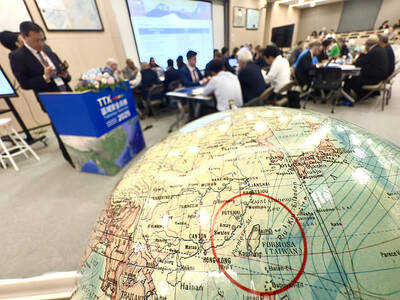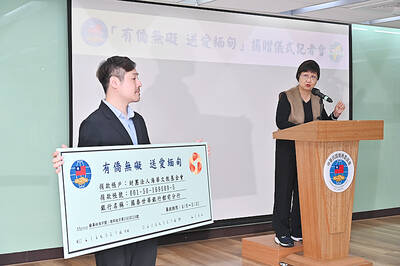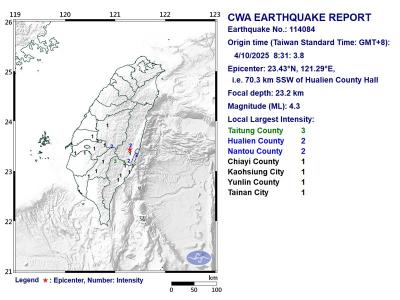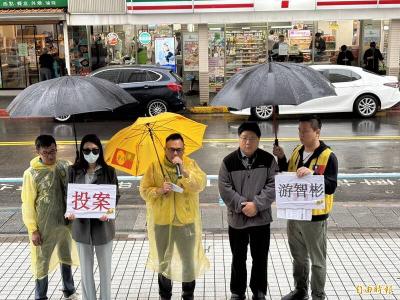Twenty-six Ministry of Health and Welfare hospitals emitted about 99,000 tonnes of carbon dioxide equivalents, which would require the planting of about 9.9 million trees to offset, a ministry report released yesterday showed.
A UN estimation suggests that an average tree can absorb 10kg of carbon dioxide per year.
Hospital and Social Welfare Administration Commission Deputy CEO Lin Ming-nan (林名男) said the commission aims to reduce power usage at 15 of the hospitals as a result of the carbon emission verification survey of the 26 hospitals under the ministry’s jurisdiction.

Photo: Taipei Times
Lin said the survey, initiated last year as part of the government’s net zero emissions policy, found that Scope 1 emissions (including emissions from fuel combustion in vehicles, boilers and furnaces) accounted for about 11,000 tonnes, or 11.4 percent, of total emissions.
About 87,000 tonnes, or 88.6 percent, were Scope 2 emissions (emissions from purchased or acquired energy, such as electricity), the survey showed.
“Electricity use is still the main source of carbon emissions,” Lin said.
Fifteen of the hospitals are categorized by Taiwan Power Co as high-voltage electricity users.
An analysis on their power usage found that air-conditioning generally used the most electricity.
To reduce power usage at the 15 hospitals, the commission has initiated an energy-saving program, which aims to complete an electricity usage review and improvement plan by the end of October, Lin said.
Preliminary projects carried out at five hospitals have saved about an accumulated 1.1 gigawatts, he said.
Dalin Tzu Chi General Hospital in Chiayi County emits about 12,000 tonnes of carbon dioxide equivalents a year, lower than several medical centers such as National Taiwan University Hospital or Taipei Veterans General Hospital, Lin said.
Some hospitals have invested in saving energy for many years, while some have just started, he said.
As health ministry-affiliated hospitals include large, medium and small institutions, as well as hospitals in remote areas, their carbon emissions and improvement potentials differ, he said.
The commission would consider each hospital’s conditions to set different carbon reduction goals, while the superintendent of each hospital would be the executive director of their sustainable development committee, leading a team to reduce carbon emissions, he said.
The survey is just a starting point, as carbon emission verification reviews would be conducted regularly to find “hot spots” of carbon emissions and make improvements, Lin said.
Hospitals would continue to cultivate sustainable management talent, deepen green efforts in their facilities, promote energy efficiency by introducing digitalization and low carbonization, and conduct studies on sustainable and net zero practices, he said.
Lin said the commission encourages people to reduce power usage in their daily lives, such as by taking the stairs instead of the elevator, and taking public transportation or riding a bicycle to work — as he does — instead of driving.
The commission also urges people to participate in “Meatless Monday,” use digital documents to reduce paper waste and engage in other carbon-reduction efforts, he added.

DEFENSE: The National Security Bureau promised to expand communication and intelligence cooperation with global partners and enhance its strategic analytical skills China has not only increased military exercises and “gray zone” tactics against Taiwan this year, but also continues to recruit military personnel for espionage, the National Security Bureau (NSB) said yesterday in a report to the Legislative Yuan. The bureau submitted the report ahead of NSB Director-General Tsai Ming-yen’s (蔡明彥) appearance before the Foreign and National Defense Committee today. Last year, the Chinese People’s Liberation Army (PLA) conducted “Joint Sword-2024A and B” military exercises targeting Taiwan and carried out 40 combat readiness patrols, the bureau said. In addition, Chinese military aircraft entered Taiwan’s airspace 3,070 times last year, up about

The Overseas Community Affairs Council (OCAC) yesterday announced a fundraising campaign to support survivors of the magnitude 7.7 earthquake that struck Myanmar on March 28, with two prayer events scheduled in Taipei and Taichung later this week. “While initial rescue operations have concluded [in Myanmar], many survivors are now facing increasingly difficult living conditions,” OCAC Minister Hsu Chia-ching (徐佳青) told a news conference in Taipei. The fundraising campaign, which runs through May 31, is focused on supporting the reconstruction of damaged overseas compatriot schools, assisting students from Myanmar in Taiwan, and providing essential items, such as drinking water, food and medical supplies,

A magnitude 4.3 earthquake struck eastern Taiwan's Hualien County at 8:31am today, according to the Central Weather Administration (CWA). The epicenter of the temblor was located in Hualien County, about 70.3 kilometers south southwest of Hualien County Hall, at a depth of 23.2km, according to the administration. There were no immediate reports of damage resulting from the quake. The earthquake's intensity, which gauges the actual effect of a temblor, was highest in Taitung County, where it measured 3 on Taiwan's 7-tier intensity scale. The quake also measured an intensity of 2 in Hualien and Nantou counties, the CWA said.

New Party Deputy Secretary-General You Chih-pin (游智彬) this morning went to the National Immigration Agency (NIA) to “turn himself in” after being notified that he had failed to provide proof of having renounced his Chinese household registration. He was one of more than 10,000 naturalized Taiwanese citizens from China who were informed by the NIA that their Taiwanese citizenship might be revoked if they fail to provide the proof in three months, people familiar with the matter said. You said he has proof that he had renounced his Chinese household registration and demanded the NIA provide proof that he still had Chinese